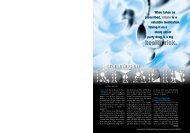You also want an ePaper? Increase the reach of your titles
YUMPU automatically turns print PDFs into web optimized ePapers that Google loves.
Copyright © by Holt, Rinehart and Winston. All rights reserved.<br />
CHAPTER 9<br />
<strong>Fluid</strong> <strong>Mechanics</strong><br />
PHYSICS IN ACTION<br />
Whitewater rafters and kayakers know<br />
that a river does not flow at the same<br />
rate at all points in the river. Along some<br />
stretches of river, the water moves slowly<br />
and smoothly. In other parts, the water<br />
races and rolls in the turbulence of the<br />
rapids.<br />
Rafters can plan for what’s ahead in the<br />
river if they know how the speed of the<br />
river depends on local topography. The<br />
rate at which a river flows depends in<br />
large part on the cross-sectional area of<br />
the water at a given point along the river.<br />
Where the river is deep and wide, it<br />
moves slowly. Where the river is shallow<br />
or narrow, the water moves faster and<br />
may form turbulent rapids.<br />
• Why does a raft float on water?<br />
• Why is water turbulent in the rapids and<br />
smooth in other places on a river?<br />
CONCEPT REVIEW<br />
Force (Section 4-1)<br />
Energy (Section 5-2)<br />
Conservation laws (Section 5-3)<br />
<strong>Fluid</strong> <strong>Mechanics</strong> 317<br />
Tapping Prior<br />
Knowledge<br />
Knowledge to Expect<br />
✔ “There are formulas for calculating<br />
the surface areas<br />
and volumes of regular<br />
shapes. When the linear size<br />
of a shape changes by some<br />
factor, its area changes in<br />
proportion to the square of<br />
the factor, and the volume<br />
in proportion to its cube.”<br />
(AAAS’s Benchmarks for Science<br />
Literacy, grades 9–12)<br />
✔ “By the age of 14 (and<br />
depending on context), students<br />
typically understand<br />
conservation of length and<br />
amount, area, weight, and<br />
displaced volume.” (AAAS’s<br />
Benchmarks for Science Literacy,<br />
The Research Base)<br />
Knowledge to Review<br />
✔ Forces can cause changes in<br />
an object’s motion or in its<br />
shape.<br />
(Section 4-1)<br />
✔ Energy can be kinetic energy<br />
or potential energy.<br />
(Section 5-2)<br />
✔ In the absence of friction,<br />
the total mechanical energy<br />
of a system is constant. The<br />
total mass of a closed system<br />
is constant.<br />
(Section 5-3)<br />
Items to Probe<br />
✔ Operational understanding<br />
of the concepts of area and<br />
volume: Ask students to<br />
compare the volume of containers<br />
of different shapes<br />
(<strong>with</strong> approximately the<br />
same capacity).<br />
✔ Ability to relate density,<br />
mass, and volume in a<br />
meaningful way: Ask students<br />
to calculate m, given r<br />
and V, using correct units.<br />
317
















